Caucasian Gentiana Species: Untargeted LC-MS Metabolic Profiling, Antioxidant and Digestive Enzyme Inhibiting Activity of Six Plants
Abstract
:1. Introduction
2. Results and Discussion
2.1. Liquid Chromatography Mass Spectrometric (LC-MS) Metabolite Profiling of Six Caucasian Gentians: Chemodiversity of Herbs and Roots
2.1.1. Carbohydrates
2.1.2. Iridoid Glycosides
2.1.3. Phenolic Acid O-glycosides
2.1.4. Hydroxycinnamates
2.1.5. Xanthones
2.1.6. Flavonoids
2.1.7. Triterpene Glycosides
2.2. HPLC-DAD Quantification of Selected Compounds in Six Caucasian Gentians: Comparison of Herb and Roots
2.3. Bioactivity of Gentian Extracts as a Function of Phenolic Compounds Content
3. Conclusions
4. Materials and Methods
4.1. Plant Materials and Chemicals
4.2. Total Extract Preparation
4.3. High-Performance Liquid Chromatography with Diode Array Detection and Electrospray Ionization Triple Quadrupole Mass Spectrometric Detection (HPLC-DAD-ESI-QQQ-MS)
4.4. HPLC-DAD Quantification
4.5. Validation Analysis
4.6. Antioxidant Activity Analysis
4.7. Digestive Enzymes Inhibiting Potential
4.8. Statistical and Multivariative Analysis
Supplementary Materials
Author Contributions
Funding
Acknowledgments
Conflicts of Interest
References
- The Plant List. Available online: http://www.theplantlist.org/1.1/browse/A/Gentianaceae/Gentiana/ (accessed on 24 September 2019).
- Sirotuk, E.A. The Gentians of the West Caucasus: The aspects of biology and conservation. Ph.D. Thesis, Kuban State Agrarian University, Krasnodar, Russia, 22 March 2007. [Google Scholar]
- Mamedov, N.; Mehdiyeva, N.P.; Craker, L.E. Medicinal plants used in traditional medicine of the Caucasus and North America. J. Med. Act. Plants 2015, 4, 42–66. [Google Scholar] [CrossRef]
- Ibadullayeva, S.J.; Mamedova, S.E.; Sultanova, Z.R.; Movsumova, N.V.; Jafarli, I.A. Medicinal plants of Azerbaijan flora used in the treatment of certain diseases. Afr. J. Pharm. Pharmacol. 2010, 4, 545–548. [Google Scholar]
- Karyagin, I.I. Flora of Azerbaijan; Academy of Science: Baku, Azerbaijan, 1957; Volume 7, pp. 87–99. [Google Scholar]
- Bussmann, R.W.; Paniagua, Z.N.Y.; Sikharulidze, S.; Kikvidze, Z.; Kikodze, D.; Tchelidze, D.; Batsatsashvili, K.; Hart, R.E. Medicinal and food plants of Svaneti and Lechkhumi, Sakartvelo (Republic of Georgia), Caucasus. Med. Aromat. Plants 2016, 5, 5. [Google Scholar] [CrossRef]
- Damirov, I.A.; Prilipko, L.I.; Shukurov, D.Z.; Kerimov, U.B. Medical Plants of Azerbaijan; Baku: Baku, Azerbaijan, 1983; pp. 310–319. [Google Scholar]
- Bussmann, R.W.; Paniagua Zambrana, N.Y.; Sikharulidze, S.; Kikvidze, Z.; Kikodze, D.; Tchelidze, D.; Khutsishvili, M.; Batsatsashvili, K.; Hart, R.E. A comparative ethnobotany of Khevsureti, Samtskhe-Javakheti, Tusheti, Svaneti, and Racha-Lechkhumi, Republic of Georgia (Sakartvelo), Caucasus. J. Ethnobiol. Ethnomed. 2016, 12, 43. [Google Scholar] [CrossRef]
- Gagiidze, R.I.; Kutateladze, S.I. Flora of Georgia; Metzniereba: Tbilisi, Georgia, 1985; Volume 10, pp. 123–140. [Google Scholar]
- Sokolov, P.D. (Ed.) Plant Resources of USSR; Nauka: Leningrad, Russia, 1990; Volume 5, pp. 50–58. [Google Scholar]
- Rollov, A.K.H. Wild-Growing Plants of Caucasus: Distribution, Properties and Uses; Nauka: Tyfliz, Georgia, 1908; pp. 598–599. [Google Scholar]
- Olennikov, D.N.; Kashchenko, N.I.; Chirikova, N.K.; Tankhaeva, L.M. Iridoids and flavonoids of four Siberian gentians: Chemical profile and gastric stimulatory effect. Molecules 2015, 20, 19172–19188. [Google Scholar] [CrossRef]
- Olennikov, D.N.; Kashchenko, N.I.; Chirikova, N.K.; Koryakina, L.P.; Vladimirov, L.N. Bitter gentian teas: Nutritional and phytochemical profiles, polysaccharide characterisation and bioactivity. Molecules 2015, 20, 20014–20030. [Google Scholar] [CrossRef]
- Olennikov, D.N.; Chirikova, N.K. Algidisides I and II, new iridoids glycosides from Gentiana algida. Chem. Nat. Compd. 2016, 52, 550–554. [Google Scholar] [CrossRef]
- Goetz, M.; Hostettmann, K.; Jacot-Guillarmod, A. A new C-glycosylflavone from Gentiana asclepiadea. Phytochemistry 1976, 15, 2014. [Google Scholar] [CrossRef]
- Kitanov, G.M.; Van, D.T.; Asenov, I.V. Chemical composition of the roots of Gentiana asclepiadea. Chem. Nat. Compd. 1991, 27, 369–370. [Google Scholar] [CrossRef]
- Goetz, M.; Hostettmann, K.; Jacot-Guillarmod, A. C-glucosides flavoniques et xanthoniques de Gentiana cruciata. Phytochemistry 1976, 15, 2015. [Google Scholar] [CrossRef]
- Popović, Z.; Krstić-Milošević, D.; Stefanović, M.; Matić, R.; Vidaković, V.; Bojović, S. Chemical and morphological inter- and intrapopulation variability in natural populations of Gentiana pneumonanthe L. Chem. Biodivers. 2019, 16, e1800509. [Google Scholar] [CrossRef] [PubMed]
- Senol, F.S.; Yagci Tuzun, C.; Toker, G.; Orhan, I.E. An in vitro perspective to cholinesterase inhibitory and antioxidant activity of five Gentiana species and Gentianella caucasea. Int. J. Food Sci. Nutr. 2012, 63, 802–812. [Google Scholar] [CrossRef]
- Goetz, M.; Jacot-Guillarmod, A. Contribution à la phytochimie du genre Gentiana, XXII. Identification de nouveaux O-glucosides de la mangiférine dans Gentiana asclepiadea L. Helv. Chim. Acta 1977, 60, 2104–2106. [Google Scholar] [CrossRef]
- Burret, F.; Chulia, A.J.; Debelmas, A.M.; Hosteltmann, K. Presence of isoscoparine, isoscoparine-7-O-glucoside and saponarine in Gentiana pneumonanthe L. Planta Med. 1978, 34, 176–179. [Google Scholar] [CrossRef]
- Mihailović, V.; Mišić, D.; Matić, S.; Mihailović, M.; Stanić, S.; Vrvić, M.M.; Katanić, J.; Mladenović, M.; Stanković, N.; Boroja, T.; et al. Comparative phytochemical analysis of Gentiana cruciata L. Roots and aerial parts, and their biological activities. Ind. Crops Prod. 2015, 73, 49–62. [Google Scholar] [CrossRef]
- Goetz, M.; Jacot-Guillarmod, A. Contribution à la phytochimie du genre Gentiana, XX. Identification de nouveaux di-O-glucosides de C-glucosylflavones dans Gentiana asclepiadea L. Helv. Chim. Acta 1977, 60, 1322–1324. [Google Scholar] [CrossRef]
- Toker, G.; Edis, M.; Yeşilada, E. Quantitative analysis of isoorientin in several Turkish Gentiana species by high performance liquid chromatography. Fabad J. Pharm. Sci. 2011, 36, 149–154. [Google Scholar]
- Goetz, M.; Jacot-Guillarmod, A. Contribution à la phytochimie du genre Gentiana, XXIV. Nouveaux C-glycosides flavoniques dans les feuilles de Gentiana asclepiadea L. Helv. Chim. Acta 1978, 61, 1373–1375. [Google Scholar] [CrossRef]
- Hostettmann-Kaldas, M.; Hostettmann, K.; Sticher, O. Xanthones, flavones and secoiridoids of american Gentiana species. Phytochemistry 1981, 20, 443–446. [Google Scholar] [CrossRef]
- Szucs, Z.; Dános, B.; Nyiredy, S.Z. Comparative analysis of the underground parts of Gentiana species by HPLC with diode-array and mass spectrometric detection. Chromatographia 2002, 56, S19–S23. [Google Scholar] [CrossRef]
- Çalis, İ.; Ersöz, T.; Chulla, A.J.; Rüedi, P. Septemfidoside: A new bis-iridoid diglucoside from Gentiana septemfida. J. Nat. Prod. 1992, 55, 385–388. [Google Scholar] [CrossRef]
- Calis, I.; Ruegger, H.; Chun, Z.; Sticher, O. Secoiridoid glucosides isolated from Gentiana gelida. Planta Med. 1990, 56, 406–409. [Google Scholar] [CrossRef] [PubMed]
- Mpondo Mpondo, E.; Chulia, A.J. 6′-O-β-D-Glucosyl gentiopicroside: A new secoiridoid from Gentiana asclepiadea. Planta Med. 1988, 54, 185–186. [Google Scholar] [CrossRef] [PubMed]
- Hayta, S.; Akgun, I.H.; Ganzera, M.; Bedir, E.; Gurel, A. Shoot proliferation and HPLC-determination of iridoid glycosides in clones of Gentiana cruciata L. Plant Cell Tissue Organ Cult. 2011, 107, 175–180. [Google Scholar] [CrossRef]
- Chulia, A.J.; Mpondo, E.M.; Nardin, R. Pneumonanthoside, premier glycoside de l’oxo-3α-ionol chez Gentiana pneumonanthe. J. Nat. Prod. 1987, 50, 248–250. [Google Scholar] [CrossRef]
- Kitanov, G.M.; Spassov, S.L. A naphthodipyranodione from Gentiana asclepiadea. Phytochemistry 1992, 31, 1067–1068. [Google Scholar] [CrossRef]
- Hudecová, A.; Hašplová, K.; Miadoková, E.; Gregáň, F.; Dušinská, M. Cytotoxic and genotoxic effect of methanolic flower extract from Gentiana asclepiadea on COS 1 cells. Neuro Endocrinol. Lett. 2010, 31, 21–25. [Google Scholar]
- Mihailović, V.; Vuković, N.; Nićiforović, N.; Mašković, P.; Stanković, M.S. Studies on the antimicrobial activity and chemical composition of the essential oils and alcoholic extracts of Gentiana asclepiadea L. J. Med. Plants Res. 2011, 5, 1164–1174. [Google Scholar]
- Hudecová, A.; Hašplová, K.; Miadoková, E.; Gregáň, F.; Dušinská, M. Gentiana asclepiadea protects human cells against oxidation DNA lesions. Cell Biochem. Funct. 2012, 30, 101–107. [Google Scholar] [CrossRef]
- Hudecová, A.; Kusznierewicz, B.; Hašplová, K.; Gálová, E.; Dušinská, M. Gentiana asclepiadea exerts antioxidant activity and enhances DNA repair of hydrogen peroxide- and silver nanoparticles-induced DNA damage. Food Chem. Toxicol. 2012, 50, 3352–3359. [Google Scholar] [CrossRef]
- Mihailović, V.; Mihailović, M.; Uskoković, A.; Solujić, S.; Matić, S. Hepatoprotective effects of Gentiana asclepiadea L. extracts against carbon tetrachloride induced liver injury in rats. Food Chem. Toxicol. 2013, 52, 83–90. [Google Scholar] [CrossRef] [PubMed]
- Stefanović, O.; Ličina, B.; Vasić, S.; Radojević, I.; Čomić, L. Bioactive extracts of Gentiana asclepiadea: Antioxidant, antimicrobial, and antibiofilm activity. Bot. Serbica 2018, 42, 223–229. [Google Scholar] [CrossRef]
- Ríos, J.L.; Francini, F.; Schinella, G.R. Natural products for the treatment of type 2 diabetes mellitus. Planta Med. 2015, 81, 975–994. [Google Scholar] [CrossRef] [PubMed]
- Massias, M.; Carbonnier, J.; Mohlo, D. Implications chimiotaxonomiques de la répartition des substances osidiques dans le genre Gentiana L. Bull. Mus. Nat. Hist. Nat. Sci. Phys. Chim. 1977, 13, 41–54. [Google Scholar]
- Pan, Y.; Zhao, Y.-L.; Zhang, J.; Li, W.-Y.; Wang, Y.-Z. Phytochemistry and pharmacological activities of the genus Gentiana (Gentianaceae). Chem. Biodivers. 2016, 13, 107–150. [Google Scholar] [CrossRef]
- Uesato, S.; Hashimoto, T.; Inouye, H. Three new secoiridoid glucosides from Eustoma russellianum. Phytochemistry 1979, 18, 1981–1986. [Google Scholar] [CrossRef]
- Tan, R.X.; Wolfender, J.-L.; Ma, W.G.; Zhang, L.X.; Hostettmann, K. Secoiridoids and antifungal aromatic acids from Gentiana algida. Phytochemistry 1996, 41, 111–116. [Google Scholar] [CrossRef]
- Wu, J.; Zhao, Z.; Wu, L.; Wang, Z. Authentication of Gentiana straminea Maxim. and its substitutes based on chemical profiling of iridoids using liquid chromatography with mass spectrometry. Biomed. Chromatogr. 2016, 30, 2061–2066. [Google Scholar] [CrossRef]
- Inouye, H.; Ueda, S.; Nakamura, Y.; Inoue, K.; Hayano, T.; Matsumura, H. Über die monoterpenglucoside und verwandte naturstoffe-XXIV. Triflorosid, ein neues secoiridoidglucosid aus Gentiana triflora var. japonica. Tetrahedron 1974, 30, 571–577. [Google Scholar] [CrossRef]
- Chen, G.; Wei, S.-H.; Yu, C.-Y. Secoiridoids from the roots of Gentiana straminea. Biochem. Syst. Ecol. 2009, 37, 766–771. [Google Scholar] [CrossRef]
- Jiang, R.-W.; Wong, K.-L.; Chan, Y.-M.; But, P.P.-H.; Shaw, P.-C. Isolation of iridoid and secoiridoid glycosides and comparative study on Radix gentianae and related adulterants by HPLC analysis. Phytochemistry 2005, 66, 2674–2680. [Google Scholar] [CrossRef] [PubMed]
- Xu, M.; Zhang, M.; Zhang, Y.-J.; Yang, C.-R. New acylated secoiridoid glucosides from Gentiana straminea (Gentianaceae). Helv. Chim. Acta 2009, 92, 321–327. [Google Scholar] [CrossRef]
- Liu, Q.; Chou, G.-X.; Wang, Z.-T. New iridoid and secoiridoid glucosides from the roots of Gentiana manshurica. Helv. Chim. Acta 2012, 95, 1094–1101. [Google Scholar] [CrossRef]
- Kim, J.A.; Son, N.S.; Son, J.K.; Jahng, Y.; Chang, H.W.; Jang, T.S.; Na, M.; Lee, S.H. Two new secoiridoid glycosides from the rhizomes of Gentiana scabra Bunge. Arch. Pharm. Res. 2009, 32, 863–867. [Google Scholar] [CrossRef] [PubMed]
- Bergeron, C.; Marston, A.; Gauthier, R.; Hostettmann, K. Iridoids and secoiridoids from Gentiana linearis. Phytochemistry 1997, 44, 633–637. [Google Scholar] [CrossRef]
- Wu, M.; Wu, P.; Liu, M.; Xie, H.; Jiang, Y.; Wei, X. Iridoids from Gentiana loureirii. Phytochemistry 2009, 70, 746–750. [Google Scholar] [CrossRef]
- Kitagawa, I.; Wei, H.; Nagao, S.; Mahmud, T.; Hori, K.; Kobayashi, M.; Uji, T.; Shibuya, H. Indonesian Medicinal Plants. XIV. Characterization of 3′-O-caffeoylsweroside, a new secoiridoid glucoside, and kelampayosides A and B, two new phenolic apioglucosides, from the bark of Anthocephalus chinensis (Rubiaceae). Chem. Pharm. Bull. 1996, 44, 1162–1167. [Google Scholar] [CrossRef]
- Rashid, M.A.; Gustafson, K.R.; Cardellina, J.H.; Boyd, M.R. A benzoic acid glycoside from Geniostoma antherotrichum. Phytochemistry 1996, 41, 1205–1207. [Google Scholar] [CrossRef]
- Olennikov, D.N.; Kashchenko, N.I. New flavonoids and turkesterone-2-O-cinnamate from leaves of Rhaponticum uniflorum. Chem. Nat. Compd. 2019, 55, 256–264. [Google Scholar] [CrossRef]
- Olennikov, D.N.; Chirikova, N.K.; Kashchenko, N.I.; Nikolaev, V.M.; Kim, S.-W.; Vennos, C. Bioactive phenolics of the genus Artemisia (Asteraceae): HPLC-DAD-ESI-TQ-MS/MS profile of the Siberian species and their inhibitory potential against α-amylase and α-glucosidase. Front. Pharmacol. 2018, 9, 756. [Google Scholar] [CrossRef]
- Chulia, A.J.; Mariotte, A.M. Nouvelles C-glucosylflavones chez Gentiana pedicellata. J. Nat. Prod. 1985, 48, 480–483. [Google Scholar] [CrossRef]
- Luong, M.D.; Jacot-Guillarmod, A. Contribution à la phytochimie du genre Gentiana XXI.; Les cinnamoyl-C-glucosylflavones et leurs O-glucosides dans Gentiana punctata L. Helv. Chim. Acta 1977, 60, 2099–2103. [Google Scholar] [CrossRef]
- Luong, M.D.; Fombasso, P.; Jacot-Guillarmod, A. Contribution à la phytochimie du genre Gentiana. XXV. Etude des composés flavoniques et xanthoniques dans les feuilles de Gentiana × marcailhouana RY. Nouveaux cinnamoyl-C-glucosides flavoniques. Helv. Chim. Acta 1980, 63, 244–249. [Google Scholar] [CrossRef]
- Krauze-Baranowska, M.; Cisowski, W. Flavone C-glycosides from Bryonia alba and B. dioica. Phytochemistry 1995, 39, 727–729. [Google Scholar] [CrossRef]
- Marston, A.; Hostettmann, K.; Jacot-Guillarmod, A. Contribution à la phytochimie du genre Gentiana, XIX. Identification de nouveaux C-glucosides flavoniques dans Gentiana pyrenaica L. Helv. Chim. Acta 1976, 59, 2596–2600. [Google Scholar] [CrossRef]
- Rhourri-Frih, B.; Chaimbault, P.; Claude, B.; André, P.; Lafosse, M. Analysis of pentacyclic triterpenes by LC-MS. A comparative study between APCI and APPI. J. Mass Spectrom. 2009, 44, 71–80. [Google Scholar] [CrossRef]
- Olennikov, D.N. Makisterone C-20,22-acetonide from Rhaponticum uniflorum. Chem. Nat. Compd. 2018, 54, 930–933. [Google Scholar] [CrossRef]
- Gil, M.; Wianowska, D. Chlorogenic acids—Their properties, occurrence and analysis. Ann. Univ. Mariae Curie Skłodowska 2017, 72, 61–104. [Google Scholar] [CrossRef]
- Hostettmann, K.; Wagner, H. Xanthone glycosides. Phytochemistry 1977, 16, 821–829. [Google Scholar] [CrossRef]
- Struwe, L.; Albert, V.A. (Eds.) Gentianaceae: Systematics and Natural History; Cambridge University Press: Cambridge, UK, 2002; pp. 602–604. [Google Scholar]
- Jyotshna; Khare, P.; Shanker, K. Mangiferin: A review of sources and interventions for biological activities. Biofactors 2016, 42, 504–514. [Google Scholar] [CrossRef]
- Olennikov, D.N.; Chirikova, N.K.; Okhlopkova, Z.M.; Zulfugarov, I.S. Chemical composition and antioxidant activity of Tánara Ótó (Dracocephalum palmatum Stephan), a medicinal plant used by the North-Yakutian nomads. Molecules 2013, 18, 14105–14121. [Google Scholar] [CrossRef] [PubMed]
- Olennikov, D.N.; Kashchenko, N.I.; Chirikova, N.K.; Vasil’eva, A.G.; Gadimli, A.I.; Isaev, J.I.; Vennos, C. Caffeoylquinic acids and flavonoids of fringed sagewort (Artemisia frigida Willd.): HPLC-DAD-ESI-QQQ-MS profile, HPLC-DAD quantification, in vitro digestion stability, and antioxidant capacity. Antioxidants 2019, 8, 307. [Google Scholar] [CrossRef] [PubMed]
- Krishnaiah, D.; Sarbatly, R.; Nithyanandam, R. A review of the antioxidant potential of medicinal plant species. Food Bioprod. Process. 2011, 89, 217–233. [Google Scholar] [CrossRef]
- Olennikov, D.N.; Kashchenko, N.I.; Chirikova, N.K. A novel HPLC-assisted method for investigation of the Fe2+-chelating activity of flavonoids and plant extracts. Molecules 2014, 19, 18296–18316. [Google Scholar] [CrossRef]
- Olennikov, D.N.; Chirikova, N.K.; Vennos, C. Chemical composition, antioxidant and anticholinesterase activities of Gentianella azurea from Russian Federation. Nat. Prod. Commun. 2017, 12, 55–56. [Google Scholar] [CrossRef]
- Olennikov, D.N.; Kashchenko, N.I. Spireasalicin, a new acylated glycoside of quercetin from Spiraea salicicfolia. Chem. Nat. Compd. 2017, 53, 1038–1044. [Google Scholar] [CrossRef]
- Olennikov, D.N.; Kruglova, M.Y. A new quercetin glycoside and other phenolic compounds from the genus Filipendula. Chem. Nat. Compd. 2013, 49, 610–616. [Google Scholar] [CrossRef]
- Olennikov, D.N.; Chirikova, N.K. Caffeoylglucaric acids and other phenylpropanoids of the Siberian Leonurus species. Chem. Nat. Compd. 2016, 52, 780–782. [Google Scholar] [CrossRef]
- Olennikov, D.N.; Partilkhaev, V.V. Flavonoids and phenylpropanoids from several species of Bupleurum growing in Buryatia. Chem. Nat. Compd. 2012, 48, 972–976. [Google Scholar] [CrossRef]
- Olennikov, D.N. Chemical investigation of Anagallidium dichotomum and anticholinesterase activity of its constituents. Chem. Nat. Compd. 2013, 49, 977–979. [Google Scholar] [CrossRef]
- Olennikov, D.N. Ecdysteroids, flavonoids, and phenylpropanoids from Silene nutans. Chem. Nat. Compd. 2019, 55, 127–130. [Google Scholar] [CrossRef]
- Olennikov, D.N. Phytoecdysteroids and flavonoids from Gastrolychnis tristis. Chem. Nat. Compd. 2018, 54, 204–206. [Google Scholar] [CrossRef]
- Olennikov, D.N.; Chirikova, N.K. New C,O-glycosylflavones from Melandrium divaricatum. Chem. Nat. Compd. 2019, 55, 890–895. [Google Scholar]
- Olennikov, D.N.; Chirikova, N.K. C-Glycosyl flavones from two Eastern Siberian species of Silene. Chem. Nat. Compd. 2019, 55, 642–647. [Google Scholar] [CrossRef]
- Olennikov, D.N.; Kashchenko, N.I.; Chirikova, N.K. Meadowsweet teas as new functional beverages: Comparative analysis of nutrients, phytochemicals and biological effects of four Filipendula species. Molecules 2017, 22, 16. [Google Scholar] [CrossRef]
- Olennikov, D.N.; Kashchenko, N.I.; Chirikova, N.K.; Gornostai, T.G.; Selyutina, I.Y.; Zilfikarov, I.N. Effect of low temperature cultivation on the phytochemical profile and bioactivity of Arctic plants: A case of Dracocephalum palmatum. Int. J. Mol. Sci. 2017, 18, 2579. [Google Scholar] [CrossRef]
- Olennikov, D.N.; Tankhaeva, L.M.; Agafonova, S.V. Antioxidant components of Laetiporus sulphureus (Bull.: Fr.) Murr. fruit bodies. Appl. Biochem. Microbiol. 2011, 47, 419–425. [Google Scholar] [CrossRef]
- Olennikov, D.N.; Kashchenko, N.I. Componential profile and amylase inhibiting activity of phenolic compounds from Calendula officinalis L. leaves. Sci. World J. 2014, 2014, 654193. [Google Scholar] [CrossRef]
- Kashchenko, N.I.; Chirikova, N.K.; Olennikov, D.N. Agrimoniin, an active ellagitannin from Comarum palustre herb with anti-α-glucosidase and antidiabetic potential in streptozotocin-induced diabetic rats. Molecules 2017, 22, 73. [Google Scholar] [CrossRef]
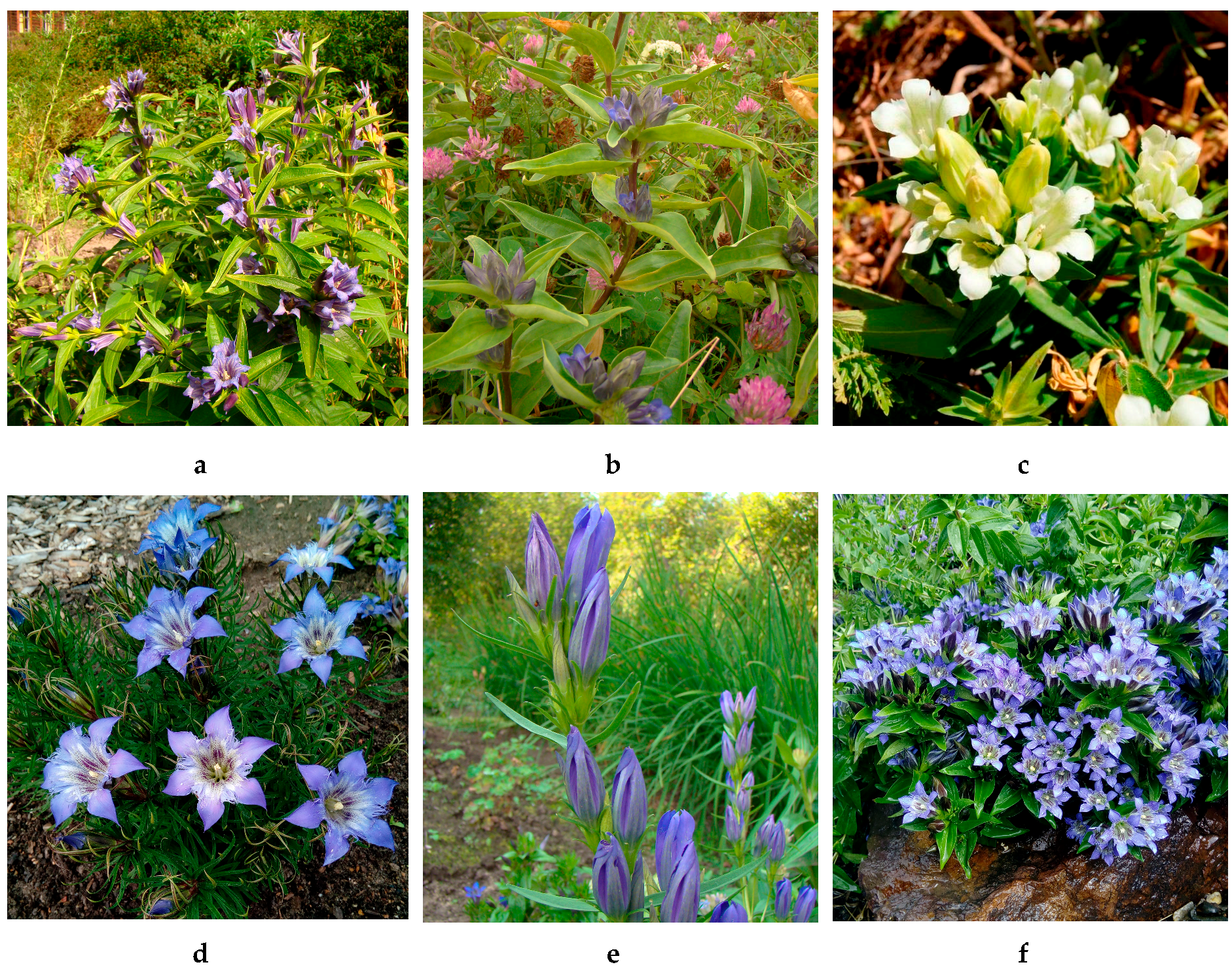

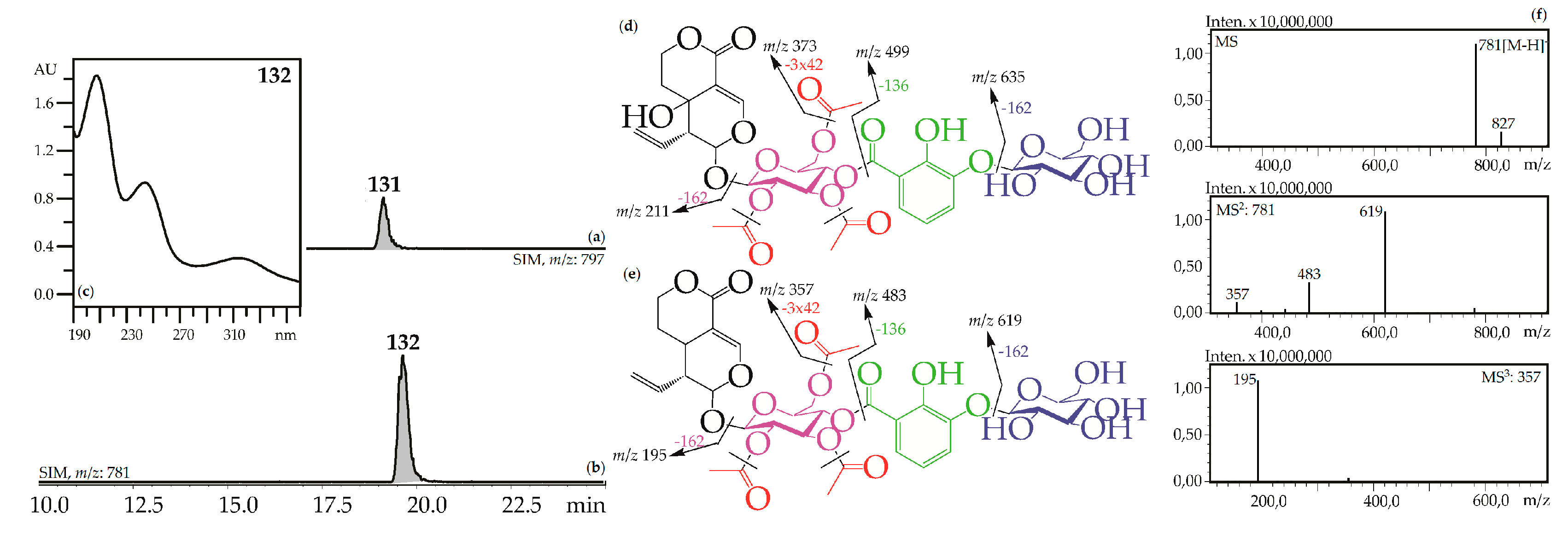


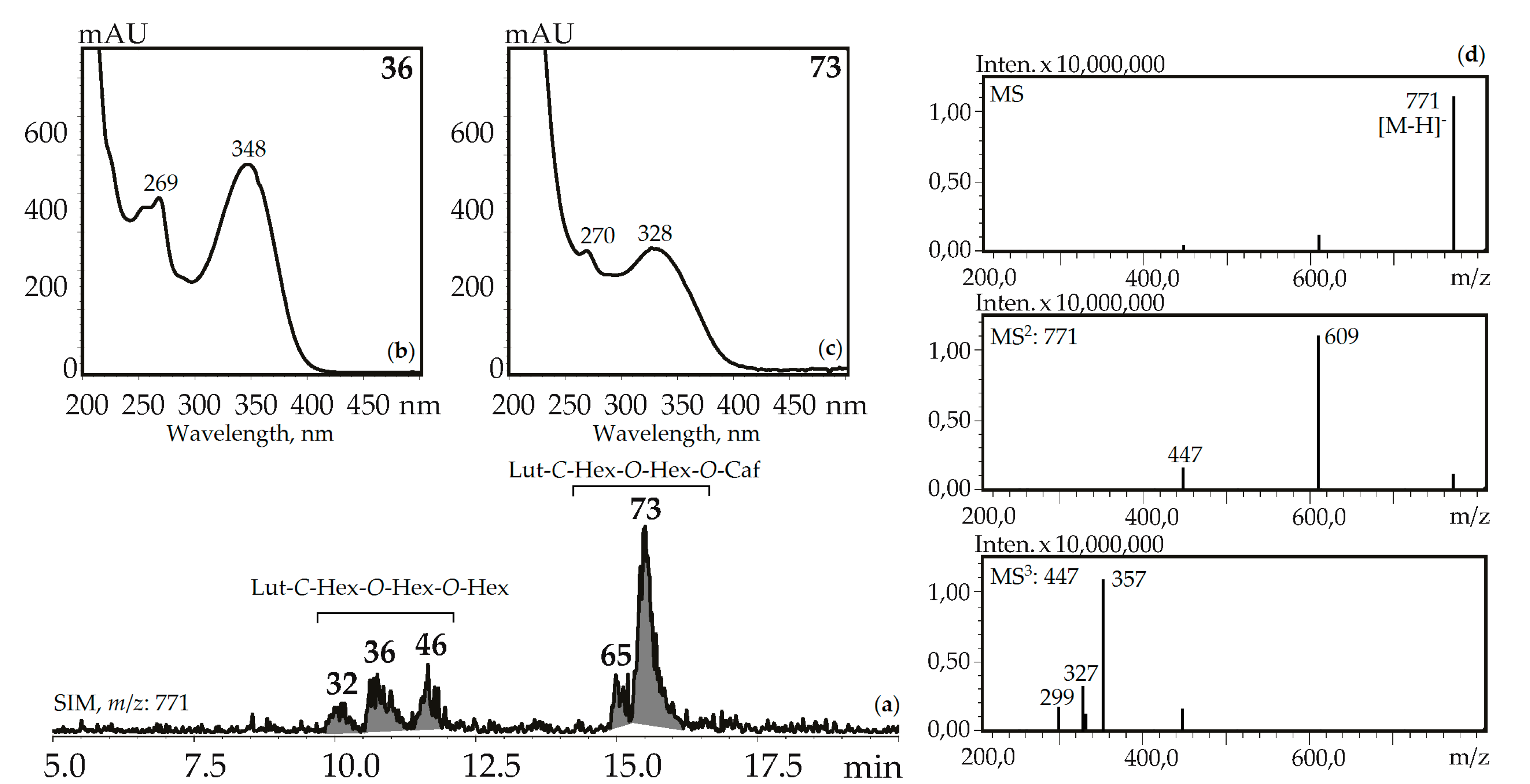
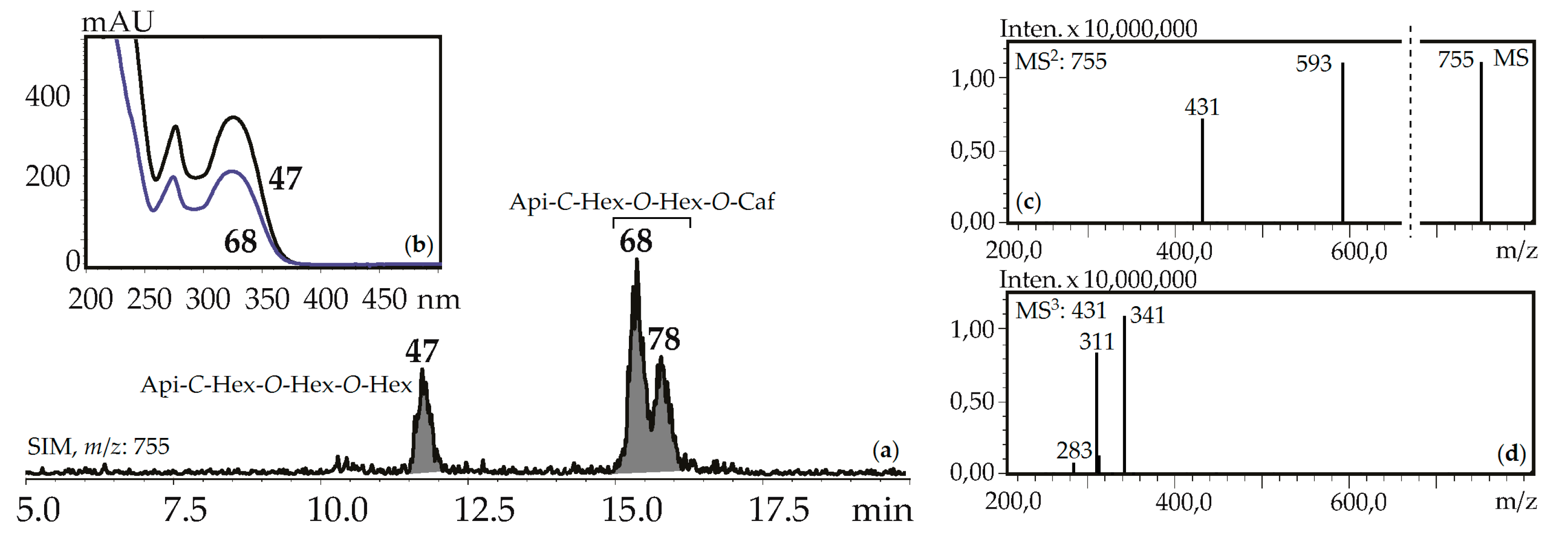
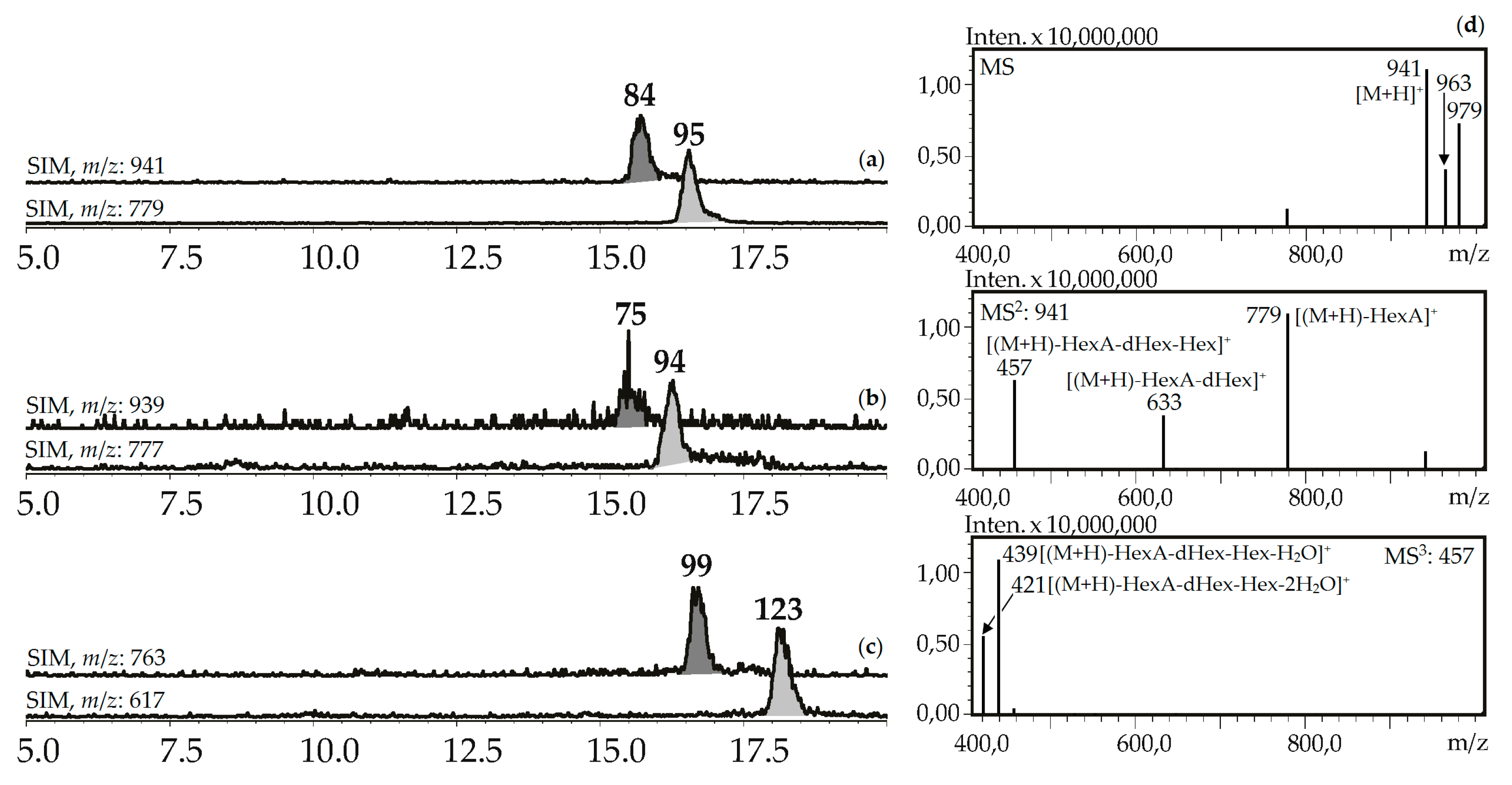
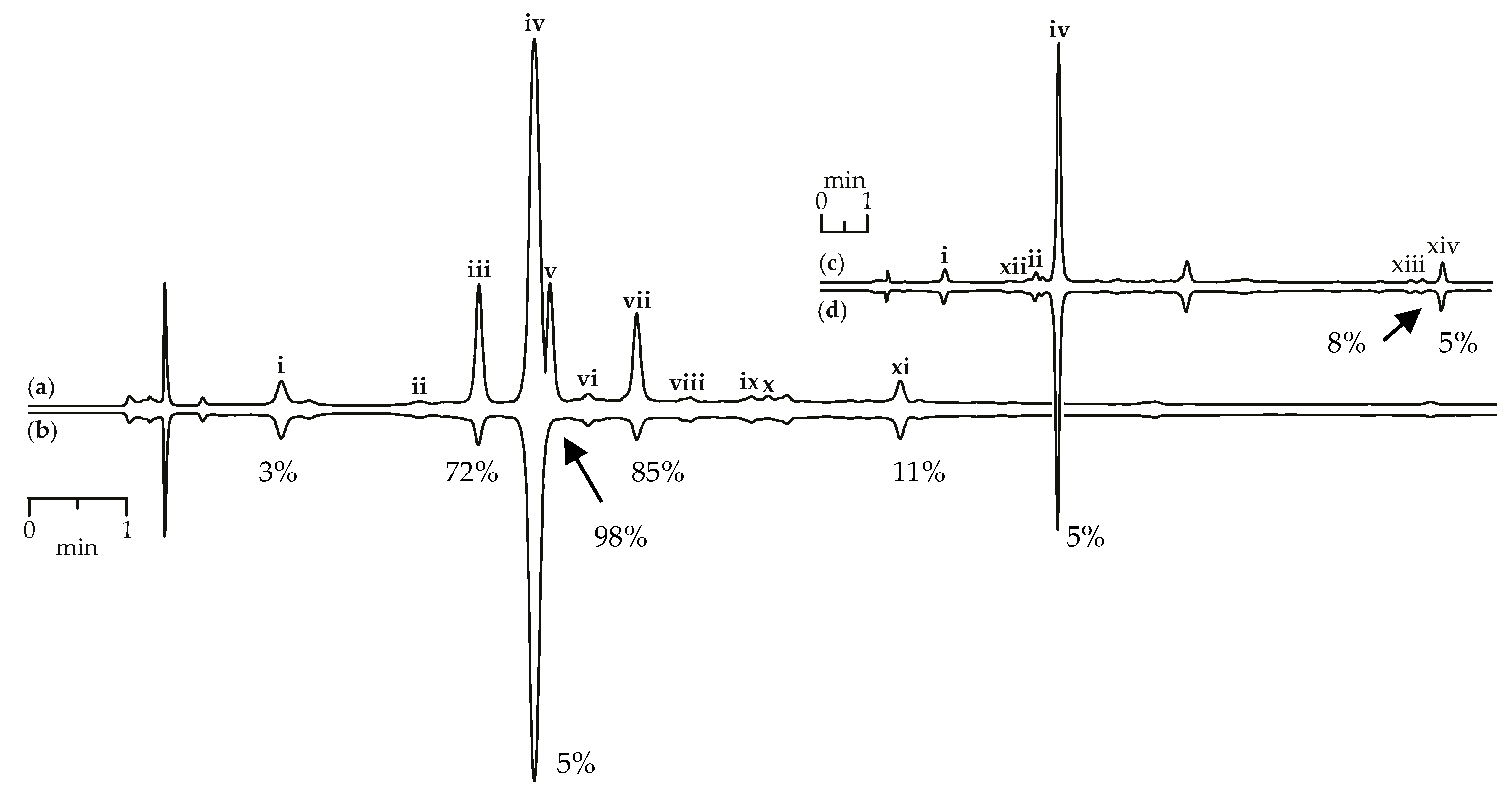
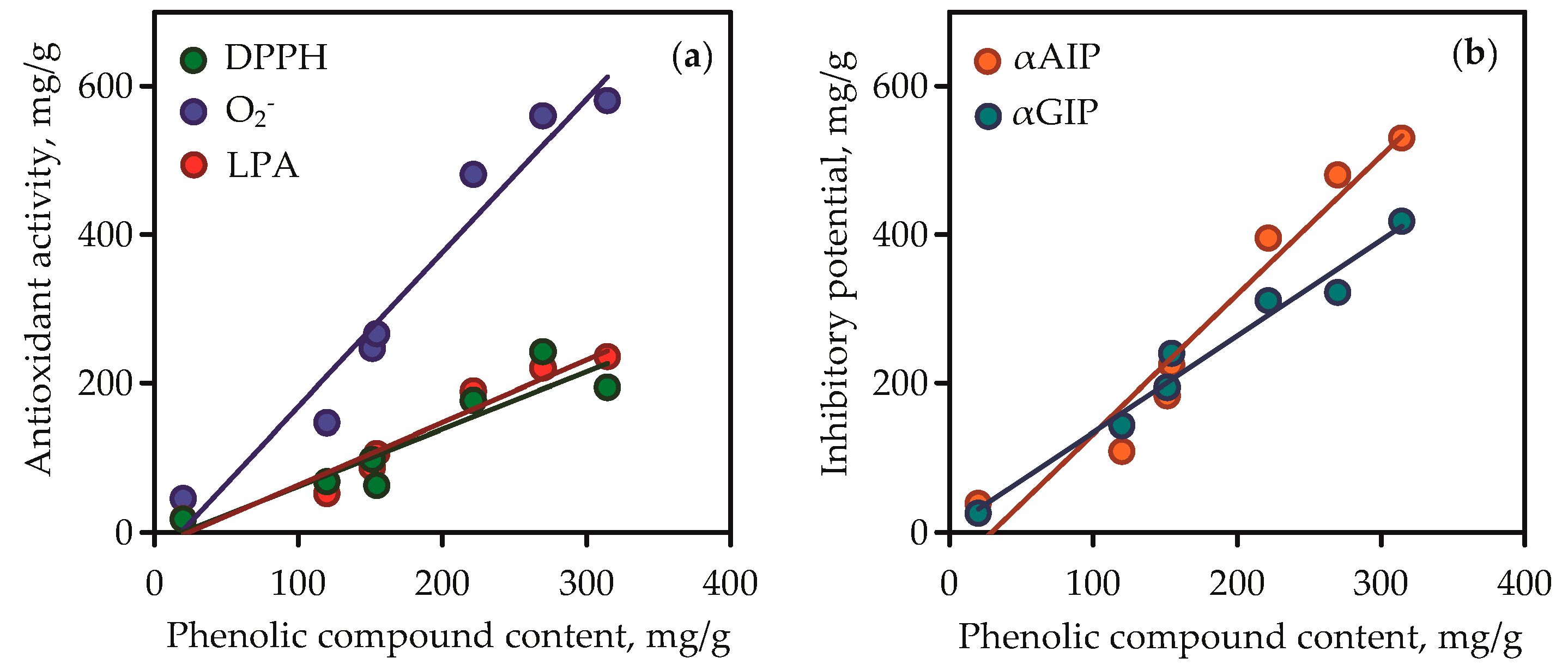
| No | tR, min | Compound | Found in Gentians 1 | |||||||||||
|---|---|---|---|---|---|---|---|---|---|---|---|---|---|---|
| Herb | Roots | |||||||||||||
| GAS | GCR | GGE | GPA | GPN | GSE | GAS | GCR | GGE | GPA | GPN | GSE | |||
| Carbohydrates | ||||||||||||||
| 1 | 2.78 | O-Hexosyl-O-hexosyl-hexose L | + | + | + | + | + | + | + | + | + | + | + | + |
| 2 | 2.83 | O-Hexosyl-hexose L | + | + | + | + | + | + | + | + | + | + | + | + |
| 4 | 3.17 | Hexose L | + | + | + | + | + | + | ||||||
| Iridoid glucosides | ||||||||||||||
| Loganic acid derivatives | ||||||||||||||
| 18 | 8.65 | Loganic acid S | + | [16] | + | + | + | [11] | + | [15] | + | + | + | + |
| 15 | 7.10 | Loganic acid-6′-O-Glc S | + | |||||||||||
| 58 | 13.79 | Loganic acid-2′-O-DOBA (algidiside I) S | + | + | ||||||||||
| 69 | 15.22 | Loganic acid-6′-O-DOBA (algidiside II) S | + | + | + | + | ||||||||
| 77 | 15.57 | Loganic acid-O-DOBA L | + | |||||||||||
| 59 | 13.84 | Loganic acid-O-DOBA-O-Hex L | + | |||||||||||
| 62 | 14.55 | Loganic acid-O-DOBA-O-Hex L | + | |||||||||||
| 82 | 15.70 | Loganic acid-O-Ac3-O-DOBA-O-Hex L | + | + | ||||||||||
| 89 | 16.06 | Loganic acid-O-Ac3-O-DOBA-O-Hex L | + | + | ||||||||||
| 130 | 19.16 | Loganic acid-O-Ac3-O-DOBA-O-Hex L | + | + | + | |||||||||
| 76 | 15.54 | Loganic acid-O-Caf L | + | |||||||||||
| Loganin derivatives | ||||||||||||||
| 25 | 9.51 | Loganin S | + | + | + | + | + | + | + | + | + | + | + | + |
| 91 | 16.19 | Loganin-O-DOBA L | + | |||||||||||
| 103 | 17.00 | Loganin-O-DOBA L | + | + | ||||||||||
| Swertiamarin derivatives | ||||||||||||||
| 33 | 10.11 | Swertiamarin S | + | [16] | [21] | + | [9] | [11] | [20] | [15] | + | + | [20] | + |
| 41 | 11.28 | Swertiamarin isomer L | + | + | + | |||||||||
| 26 | 9.58 | Swertiamarin-6′-O-Glc S | + | |||||||||||
| 8 | 5.91 | Swertiamarin-O-Hex | + | |||||||||||
| 9 | 6.16 | Swertiamarin-O-Hex | + | |||||||||||
| 134 | 21.94 | Swertiamarin-O-Ac3-O-DOBA L | + | |||||||||||
| 93 | 16.26 | Swertiamarin-O-Ac-O-DOBA-O-Hex L | + | + | ||||||||||
| 102 | 16.84 | Swertiamarin-O-Ac-O-DOBA-O-Hex L | + | + | ||||||||||
| 108 | 17.56 | Swertiamarin-O-Ac-O-DOBA-O-Hex L | + | |||||||||||
| 113 | 17.64 | Swertiamarin-O-Ac2-O-DOBA-O-Hex L | + | + | + | + | ||||||||
| 117 | 18.08 | Swertiamarin-O-Ac2-O-DOBA-O-Hex L | + | + | + | + | ||||||||
| 131 | 19.18 | Gelidoside (rindoside) S | + | + | [11] | + | + | + | + | + | ||||
| 120 | 18.10 | Swertiamarin-O-Ac3-O-DOBA-O-Hex2 L | + | + | + | |||||||||
| 128 | 18.68 | Swertiamarin-O-Ac3-O-DOBA-O-Hex2 L | + | + | + | + | ||||||||
| Gentiopicroside derivatives | ||||||||||||||
| 38 | 11.21 | Gentiopicroside S | + | [16] | [21] | + | [10] | [11] | [17] | [15] | + | + | [20] | + |
| 56 | 13.71 | Gentiopicroside isomer L | + | |||||||||||
| 27 | 9.65 | Gentiopicroside-6′-O-Glc S | [17] | + | + | + | + | |||||||
| 20 | 8.69 | Gentiopicroside-di-O-Hex L | + | + | + | |||||||||
| 74 | 15.51 | Gentiopicroside-O-DOBA L | + | |||||||||||
| 81 | 15.69 | Gentiopicroside-O-DOBA L | + | |||||||||||
| 105 | 17.10 | Amarogentin S | + | |||||||||||
| Sweroside derivatives | ||||||||||||||
| 40 | 11.26 | Sweroside S | + | [16] | + | + | [9] | [11] | [20] | [15] | + | + | [20] | + |
| 44 | 11.55 | Sweroside isomer L | + | + | + | + | + | + | + | + | + | + | ||
| 28 | 9.67 | Sweroside-6′-O-Glc S | + | + | + | + | + | |||||||
| 83 | 15.71 | Sweroside-6′-O-DOBA S | + | + | + | |||||||||
| 72 | 15.43 | Sweroside-O-DOBA-O-Hex L | + | |||||||||||
| 101 | 16.79 | Sweroside-O-Ac-O-DOBA-O-Hex L | + | + | + | + | + | + | + | |||||
| 110 | 17.60 | Sweroside-O-Ac-O-DOBA-O-Hex L | + | + | + | + | + | + | ||||||
| 111 | 17.61 | Sweroside-O-Ac3-O-DOBA L | + | |||||||||||
| 135 | 22.42 | Sweroside-O-Ac3-O-DOBA L | + | + | + | + | + | |||||||
| 121 | 18.11 | Sweroside-O-Ac2-O-DOBA-O-Hex L | + | + | + | + | + | |||||||
| 127 | 18.63 | Sweroside-O-Ac2-O-DOBA-O-Hex L | + | + | + | + | + | + | ||||||
| 132 | 19.67 | Trifloroside S | [21] | + | + | + | + | + | + | + | ||||
| 126 | 18.52 | Sweroside-O-Ac3-O-DOBA-O-Hex2 L | + | + | + | + | ||||||||
| 129 | 19.14 | Sweroside-O-Ac3-O-DOBA-O-Hex2 L | + | + | + | + | + | |||||||
| 115 | 17.67 | Sweroside-O-Caf L | + | |||||||||||
| Iridoid glucosides with various structures | ||||||||||||||
| 88 | 16.05 | Eustomorusside-O-Ac3-O-DOBA-O-Hex L | + | |||||||||||
| 12 | 6.83 | Eustoside L,T | + | [11] | ||||||||||
| 116 | 17.85 | Eustomoside-O-Ac3-O-DOBA-O-Hex (gentomoside) L,T | + | + | ||||||||||
| 133 | 19.74 | Eustomoside-O-Ac3-O-DOBA-O-Hex L | + | |||||||||||
| 14 | 6.87 | Eustomoside L,T | + | + | [11] | |||||||||
| 23 | 9.15 | Morroniside S | + | |||||||||||
| 31 | 9.99 | Septemfidoside L,T | [11] | |||||||||||
| Iridoid glucosides with unknows structures | ||||||||||||||
| 3 | 3.05 | Iridoid glycoside (MW 408) | + | + | + | |||||||||
| 5 | 3.62 | Iridoid glycoside (MW 408) | + | |||||||||||
| 6 | 5.56 | Iridoid glycoside (MW 408) | + | + | + | + | + | |||||||
| 10 | 6.39 | Iridoid glycoside (MW 408) | + | + | + | + | ||||||||
| 13 | 6.85 | Iridoid glycoside (MW 408) | + | + | ||||||||||
| 17 | 7.76 | Iridoid glycoside (MW 408) | + | + | ||||||||||
| 19 | 8.67 | Iridoid glycoside (MW 408) | + | + | + | |||||||||
| 96 | 16.62 | Iridoid glycoside (MW 436) | + | |||||||||||
| 22 | 9.06 | Iridoid glycoside (MW 446) | + | + | ||||||||||
| 24 | 9.25 | Iridoid glycoside (MW 446) | + | |||||||||||
| 7 | 5.75 | Iridoid glycoside (MW 478) | + | |||||||||||
| 86 | 15.78 | Iridoid glycoside (MW 562) | + | |||||||||||
| 100 | 16.75 | Iridoid glycoside (MW 562) | + | + | ||||||||||
| 67 | 15.04 | Iridoid glycoside (MW 684) | + | + | + | |||||||||
| Phenolic acid O-glucosides | ||||||||||||||
| 11 | 6.81 | 2,3-Dihydroxybenzoic acid-O-Hex L | + | + | + | + | + | + | + | + | + | |||
| 16 | 7.45 | 2,3-Dihydroxybenzoic acid-O-Hex L | + | + | + | + | + | + | + | + | + | |||
| Hydroxycinnamates | ||||||||||||||
| 21 | 8.71 | 1-O-Caffeoyl-glucose S | + | |||||||||||
| 45 | 11.63 | 6-O-Caffeoyl-glucose S | + | |||||||||||
| 51 | 12.36 | 2-O-Caffeoyl-glucaric acid S | + | |||||||||||
| 79 | 15.68 | 1,3-Di-O-caffeoyl-glycerol S | + | |||||||||||
| 90 | 16.17 | 1,2-Di-O-caffeoyl-glycerol L,T | + | |||||||||||
| Xanthones | ||||||||||||||
| 49 | 12.22 | Mangiferin S | [1] | [14] | + | [8] | ||||||||
| 50 | 12.32 | Isomangiferin S | + | + | + | |||||||||
| 30 | 9.92 | Mangiferin isomer L | + | |||||||||||
| 39 | 11.25 | Mangiferin isomer L | + | |||||||||||
| 34 | 10.14 | Mangiferin-6-O-Glc L,T | [3] | + | + | + | ||||||||
| 29 | 9.76 | Mangiferin-7-O-Glc (neomangiferin) S | [3] | + | + | + | ||||||||
| 137 | 22.85 | Gentisin S | [20] | |||||||||||
| 109 | 17.58 | Gentisin-1-O-Prim (gentioside) S | + | |||||||||||
| Flavonoids | ||||||||||||||
| Luteolin derivatives | ||||||||||||||
| 98 | 16.70 | Luteolin-7-O-Glc S | + | + | ||||||||||
| 61 | 14.08 | Luteolin-6-C-Glc (isoorientin) S | [1] | [14] | + | + | [10] | [12] | [18] | |||||
| 80 | 15.69 | Luteolin-8-C-Glc (orientin) S | + | + | ||||||||||
| 35 | 11.07 | Isoorientin-7-O-Glc S | + | |||||||||||
| 43 | 11.51 | Isoorientin-2″-O-Glc S | [1] | + | + | + | + | + | + | |||||
| 52 | 12.47 | Isoorientin-4″-O-Glc S | + | + | + | + | + | |||||||
| 54 | 13.34 | Isoorientin-6″-O-Glc S | + | + | + | + | + | |||||||
| 63 | 14.59 | Luteolin-C-Hex-O-Hex L | + | |||||||||||
| 97 | 16.63 | Isoorientin-O-Caf L | + | + | + | + | + | + | ||||||
| 32 | 10.04 | Luteolin-C-Hex-O-Hex2 L | + | |||||||||||
| 36 | 11.11 | Luteolin-C-Hex-O-Hex2 L | + | + | + | |||||||||
| 46 | 11.65 | Luteolin-C-Hex-O-Hex2 L | + | + | ||||||||||
| 65 | 15.00 | Luteolin-C-Hex-O-Hex-O-Caf L | + | + | + | + | + | + | ||||||
| 73 | 15.48 | Luteolin-C-Hex-O-Hex-O-Caf L | + | + | + | + | + | |||||||
| 66 | 15.02 | Luteolin-C-Hex-O-Hex-O-pHBA L | [4] | + | + | |||||||||
| Apigenin derivatives | ||||||||||||||
| 125 | 18.51 | Apigenin-7-O-Glc S | + | + | + | + | + | + | ||||||
| 71 | 15.41 | Isovitexin S | [1] | [14] | + | + | [10] | [13] | [18] | + | + | |||
| 42 | 11.46 | Isovitexin-7-O-Glc (saponarin) S | [3] | + | + | + | [7] | + | + | + | + | |||
| 55 | 13.48 | Isovitexin-2″-O-Glc S | [1] | + | + | + | + | |||||||
| 64 | 14.97 | Isovitexin-4′-O-Glc S | [1] | [14] | ||||||||||
| 37 | 11.12 | Isovitexin-7,2″-di-O-Glc S | + | |||||||||||
| 47 | 11.78 | Isovitexin-2″,4″-di-O-Glc S | [2] | + | ||||||||||
| 57 | 13.77 | Apigenin-C-Hex-O-Hex2 L | + | + | ||||||||||
| 107 | 17.54 | Apigenin-C-Hex-O-Caf L | + | + | + | + | + | |||||||
| 68 | 15.09 | Apigenin-C-Hex-O-Hex-O-Caf L | + | + | + | + | ||||||||
| 78 | 15.61 | Apigenin-C-Hex-O-Hex-O-Caf L | + | + | + | + | + | |||||||
| 92 | 16.24 | Apigenin-C-Hex-O-Hex-O-Caf L | + | + | + | |||||||||
| 114 | 17.65 | Apigenin-C-Hex-O-Hex-O-Caf L | + | |||||||||||
| 118 | 18.09 | Apigenin-C-Hex-O-Hex-O-Caf L | + | |||||||||||
| Chrysoeriol derivatives | ||||||||||||||
| 136 | 22.67 | Chrysoeriol S | + | + | ||||||||||
| 85 | 15.77 | Isoscoparin S | + | + | [7] | + | ||||||||
| 48 | 12.13 | Isoscoparin-7-O-Glc S | + | [7] | + | |||||||||
| 60 | 13.86 | Isoscoparin-2″-O-Glc S | + | + | ||||||||||
| 53 | 13.16 | Chrysoeriol-C-Hex-O-Hex L | + | |||||||||||
| 70 | 15.30 | Chrysoeriol-C-Hex-O-Hex-O-Caf L | + | |||||||||||
| 104 | 17.01 | Chrysoeriol-C-Hex-O-Caf L | + | |||||||||||
| 106 | 17.34 | Chrysoeriol-C-Hex-O-Caf L | + | + | + | + | ||||||||
| Acacetin derivatives | ||||||||||||||
| 87 | 15.89 | Acacetin-C-Hex-O-Hex-O-Caf L | + | + | ||||||||||
| 122 | 18.15 | Acacetin-C-Hex-O-Caf L | + | |||||||||||
| 124 | 18.20 | Acacetin-C-Hex-O-Caf L | + | |||||||||||
| Triterpene glycosides | ||||||||||||||
| 95 | 16.56 | Oleanolic acid-O-HexA-O-dHex L,T | + | + | + | |||||||||
| 84 | 15.76 | Oleanolic acid-O-HexA-O-dHex-O-Hex L,T | + | + | ||||||||||
| 94 | 16.29 | Dehydrooleanolic acid-O-HexA-O-dHex L,T | + | + | + | |||||||||
| 75 | 15.53 | Dehydrooleanolic acid-O-HexA-O-dHex-O-Hex L,T | + | + | ||||||||||
| 123 | 18.17 | Desoxyoleanolic acid-O-HexA L,T | + | + | ||||||||||
| 99 | 16.72 | Desoxyoleanolic acid-O-HexA-O-dHex L,T | + | + | ||||||||||
| 112 | 17.62 | Desoxyoleanolic acid-O-HexA-O-dHex L,T | + | |||||||||||
| Total number of compounds found | 49 | 45 | 51 | 58 | 44 | 51 | 25 | 24 | 31 | 27 | 21 | 32 | ||
| Number of previously found compounds | 11 | 8 | 3 | 0 | 9 | 10 | 7 | 4 | 0 | 0 | 3 | 0 | ||
| Number of compounds found in present study | 38 | 37 | 48 | 58 | 35 | 41 | 18 | 20 | 31 | 27 | 18 | 32 | ||
| Compound | GAS | GCR | GGE | GPA | GPN | GSE |
|---|---|---|---|---|---|---|
| Gentian herbs | ||||||
| Iridoids | ||||||
| Loganic Acid | 11.83 ± 0.21 | 3.40 ± 0.06 | 1.97 ± 0.04 | 3.91 ± 0.08 | 2.15 ± 0.04 | 4.07 ± 0.08 |
| Swertiamarin | 1.53 ± 0.03 | tr. | 9.04 ± 0.16 | 83.06 ± 1.66 | tr. | 9.47 ± 0.18 |
| Gelidoside | 0.00 | 0.00 | 7.30 ± 0.14 | 0.00 | 0.00 | 4.66 ± 0.09 |
| Gentiopicroside | 91.74 ± 1.85 | 14.77 ± 0.29 | 4.41 ± 0.08 | 79.65 ± 1.59 | 40.74 ± 0.81 | 5.08 ± 0.10 |
| Sweroside | tr. | tr. | tr. | tr. | tr. | tr. |
| Trifloroside | 0.00 | 0.00 | 2.68 ± 0.05 | 5.72 ± 0.11 | 0.00 | 1.87 ± 0.04 |
| Subtotal Iridoids | 105.10 | 18.17 | 25.40 | 172.34 | 42.89 | 25.15 |
| Flavonoids | ||||||
| Isovitexin | 0.89 ± 0.02 | 2.27 ± 0.04 | 1.05 ± 0.02 | 0.71 ± 0.02 | 0.70 ± 0.02 | 3.59 ± 0.07 |
| Isovitexin-2″-O-Glc | 1.81 ± 0.04 | 2.40 ± 0.05 | 1.39 ± 0.03 | 3.05 ± 0.06 | 1.24 ± 0.02 | 7.03 ± 0.14 |
| Saponarin | 1.25 ± 0.03 | 1.42 ± 0.03 | tr. | 2.02 ± 0.04 | 1.09 ± 0.02 | 0.83 ± 0.02 |
| Apigenin-7-O-Glc | 2.52 ± 0.07 | 0.47 ± 0.01 | 0.67 ± 0.01 | 0.91 ± 0.02 | tr. | tr. |
| Isoorientin | 18.85 ± 0.37 | 4.78 ± 0.09 | 33.59 ± 0.67 | 8.85 ± 0.17 | 21.26 ± 0.42 | 17.22 ± 0.34 |
| Isoorientin-2″-O-Glc | 40.62 ± 0.73 | 16.05 ± 0.32 | 15.16 ± 0.30 | 18.76 ± 0.37 | 4.53 ± 0.09 | 19.63 ± 0.39 |
| Isoorientin-6″-O-Glc | 0.00 | 0.00 | 3.22 ± 0.06 | 0.00 | 0.00 | 8.59 ± 0.17 |
| Luteolin-7-O-Glc | 1.33 ± 0.02 | tr. | 0.78 ± 0.02 | 1.79 ± 0.03 | 1.79 ± 0.03 | 2.52 ± 0.05 |
| Isoscoparin | 0.00 | 0.00 | 1.14 ± 0.02 | 0.00 | 1.94 ± 0.04 | 0.40 ± 0.01 |
| Subtotal Flavonoids | 67.27 | 27.39 | 57.00 | 36.09 | 32.55 | 59.81 |
| Xanthones | ||||||
| Mangiferin | 17.48 ± 0.33 | 5.75 ± 0.11 | 0.00 | 6.45 ± 0.12 | 3.03 ± 0.06 | 0.00 |
| Subtotal Xanthones | 17.48 | 5.75 | 0.00 | 6.45 | 3.03 | 0.00 |
| Total Phenolic Compounds | 84.75 | 33.14 | 57.00 | 42.54 | 35.58 | 59.81 |
| Total Compounds | 189.85 | 51.31 | 82.40 | 214.88 | 78.47 | 84.96 |
| Gentian roots | ||||||
| Iridoids | ||||||
| Loganic Acid | 11.75 ± 0.23 | 17.31 ± 0.34 | 6.14 ± 0.12 | 8.25 ± 0.16 | 11.28 ± 0.22 | 8.43 ± 0.16 |
| Swertiamarin | 5.87 ± 0.11 | 2.63 ± 0.05 | 3.47 ± 0.07 | 3.53 ± 0.07 | 3.91 ± 0.08 | 3.83 ± 0.07 |
| Gelidoside | 0.00 | 0.75 ± 0.02 | 1.53 ± 0.03 | 0.42 ± 0.01 | 0.81 ± 0.02 | 1.92 ± 0.04 |
| Gentiopicroside | 64.71 ± 1.29 | 57.51 ± 1.15 | 61.37 ± 1.22 | 62.76 ± 1.25 | 56.16 ± 1.14 | 75.90 ± 1.51 |
| Gentiopicroside-6″-O-Glc | 1.24 ± 0.02 | 0.61 ± 0.01 | 1.21 ± 0.02 | 0.00 | 0.84 ± 0.02 | 5.85 ± 0.11 |
| Sweroside | tr. | 3.84 ± 0.07 | tr. | 3.81 ± 0.07 | 2.40 ± 0.04 | 2.15 ± 0.04 |
| Trifloroside | 0.00 | 0.54 ± 0.01 | 7.07 ± 0.14 | 3.42 ± 0.06 | 2.05 ± 0.04 | 5.60 ± 0.11 |
| Subtotal Iridoids | 83.57 | 83.19 | 80.79 | 82.19 | 77.45 | 103.68 |
| Flavonoids | ||||||
| Isoorientin-2″-O-Glc | 4.43 ± 0.08 | 0.00 | 0.00 | 0.00 | 0.00 | 0.00 |
| Subtotal Flavonoids | 4.43 | 0.00 | 0.00 | 0.00 | 0.00 | 0.00 |
| Xanthones | ||||||
| Gentioside | 0.75 ± 0.02 | 0.00 | 0.00 | 0.00 | 0.00 | 0.00 |
| Subtotal Xanthones | 0.75 | 0.00 | 0.00 | 0.00 | 0.00 | 0.00 |
| Total Phenolic Compounds | 5.18 | 0.00 | 0.00 | 0.00 | 0.00 | 0.00 |
| Total Compounds | 88.75 | 83.19 | 80.79 | 82.19 | 77.45 | 103.68 |
| Extract, Compound | DPPH c | O2- d | LPA e | αAIP f | αGIP f |
|---|---|---|---|---|---|
| G. Asclepiadea Herb | 580.71 ± 14.52 vi | 220.45 ± 6.49 xii | 194.56 ± 8.36 xviii | 530.11 ± 16.31 xxvii | 418.80 ± 12.98 xxxv |
| G. Cruciata Herb | 246.34 ± 6.40 iv | 86.96 ± 3.14 x | 98.54 ± 3.46 xvii | 183.48 ± 6.62 xxiii | 194.90 ± 5.54 xxxii |
| G. Gelida Herb | 481.49 ± 14.43 v | 189.14 ± 6.05 xi | 176.88 ± 6.37 xviii | 395.17 ± 14.02 xxv | 311.48 ± 11.78 xxxiv |
| G. Paradoxa Herb | 147.57 ± 3.09 iii | 52.18 ± 2.03 x | 68.17 ± 2.12 xvi | 108.85 ± 3.71 xxii | 144.77 ± 3.05 xxxii |
| G. Pneumonante Herb | 266.96 ± 8.72 iv | 106.53 ± 3.62 xi | 63.23 ± 4.03 xvi | 224.06 ± 8.29 xxiv | 240.20 ± 6.91 xxxiii |
| G. Septemfida Herb | 560.86 ± 12.18 vi | 235.54 ± 7.02 xii | 242.08 ± 7.59 xix | 480.20 ± 11.94 xxvi | 322.02 ± 11.69 xxxiv |
| G. Asclepiadea Roots | 45.32 ± 1.17 ii | 18.48 ± 0.66 ix | 17.68 ± 0.71 xv | 38.87 ± 1.51 xxi | 25.64 ± 0.97 xxx |
| G. Cruciata Roots | < 10.00 | < 10.00 | < 10.00 | < 10.00 | < 10.00 |
| G. Gelida Roots | < 10.00 | < 10.00 | < 10.00 | < 10.00 | < 10.00 |
| G. Paradoxa Roots | < 10.00 | < 10.00 | < 10.00 | < 10.00 | < 10.00 |
| G. Pneumonante Roots | < 10.00 | < 10.00 | 11.27 ± 0.51 xv | < 10.00 | 14.23 ± 0.56 xxix |
| G. Septemfida Roots | < 10.00 | < 10.00 | < 10.00 | < 10.00 | < 10.00 |
| Loganic Acid | < 10.00 | < 10.00 | < 10.00 | < 10.00 | < 10.00 |
| Gentiopicroside | < 10.00 | < 10.00 | < 10.00 | < 10.00 | < 10.00 |
| Gelidoside | 25.14 ± 0.42 i | < 10.00 | < 10.00 | < 10.00 | < 10.00 |
| Trifloroside | 20.82 ± 0.38 i | < 10.00 | < 10.00 | < 10.00 | < 10.00 |
| Isovitexin | 425.11 ± 8.50 v | 211.63 ± 4.20 xii | 96.54 ± 3.73 xvii | 108.35 ± 3.79 xxii | 52.63 ± 2.09 xxxi |
| Isoorientin | 2523.27 ± 50.46 vii | 863.15 ± 17.26 xiii | 486.56 ± 19.46 xx | 1242.03 ± 44.71 xxviii | 811.10 ± 32.44 xxxvi |
| Mangiferin | 3824.20 ± 76.48 viii | 927.07 ± 18.54 xiv | 522.14 ± 20.85 xx | 296.14 ± 10.36 xxiv | 1562.84 ± 62.48 xxxvii |
| Collection Place | Collection Date | Coordinates | Voucher Specimens No | Dry Extract Yield (Herb / Root), % a |
|---|---|---|---|---|
| Gentiana asclepiadea L. (syn. G. schistocalyx K.Koch) | ||||
| Baş Göynük, Shekinskii District, Azerbaijan | 23.VIII.2018 | 41°11′03.8″N 47°00′29.8″E | AZ/GEN-0818/15-003 | 28.2 / 25.6 |
| Gentiana cruciata L. | ||||
| Cek, Gubinskii District, Azerbaijan | 18.VI.2018 | 41°12′25.8″N 48°14′40.6″E | AZ/GEN-0618/11-002 | 21.4 / 19.6 |
| Gentiana gelida M.Bieb. | ||||
| Batabat, Shakhbuz District, Azerbaijan | 05.VIII.2018 | 39°32′15.8″N 45°44′10.1″E | AZ/GEN-0818/02-074 | 25.1 / 23.7 |
| Gentiana paradoxa Albov | ||||
| Mamdzyshkha, Gagry District, Abkhazia | 20.VII.2018 | 43°18′16.0″N 40°19′37.8″E | AB/GEN-0718/17-109 | 36.5 / 22.1 |
| Gentiana pneumonanthe L. | ||||
| Kinghi, Ochamchyrskii District, Abkhazia | 15.VII.2018 | 42°48′46.8″N 41°15′56.2″E | AB/GEN-0718/14-114 | 23.6 / 20.7 |
| Gentiana septemfida Pall. (syn. G. lagodechiana (Kusn.) Grossh.) | ||||
| Laza, Gusarskii District, Azerbaijan | 25.VII.2018 | 41°03′30.1″N 47°55′36.9″E | AZ/GEN-0718/01-004 | 24.8 / 26.3 |
© 2019 by the authors. Licensee MDPI, Basel, Switzerland. This article is an open access article distributed under the terms and conditions of the Creative Commons Attribution (CC BY) license (http://creativecommons.org/licenses/by/4.0/).
Share and Cite
Olennikov, D.N.; Gadimli, A.I.; Isaev, J.I.; Kashchenko, N.I.; Prokopyev, A.S.; Kataeva, T.N.; Chirikova, N.K.; Vennos, C. Caucasian Gentiana Species: Untargeted LC-MS Metabolic Profiling, Antioxidant and Digestive Enzyme Inhibiting Activity of Six Plants. Metabolites 2019, 9, 271. https://doi.org/10.3390/metabo9110271
Olennikov DN, Gadimli AI, Isaev JI, Kashchenko NI, Prokopyev AS, Kataeva TN, Chirikova NK, Vennos C. Caucasian Gentiana Species: Untargeted LC-MS Metabolic Profiling, Antioxidant and Digestive Enzyme Inhibiting Activity of Six Plants. Metabolites. 2019; 9(11):271. https://doi.org/10.3390/metabo9110271
Chicago/Turabian StyleOlennikov, Daniil N., Aydan I. Gadimli, Javanshir I. Isaev, Nina I. Kashchenko, Alexey S. Prokopyev, Tatyana N. Kataeva, Nadezhda K. Chirikova, and Cecile Vennos. 2019. "Caucasian Gentiana Species: Untargeted LC-MS Metabolic Profiling, Antioxidant and Digestive Enzyme Inhibiting Activity of Six Plants" Metabolites 9, no. 11: 271. https://doi.org/10.3390/metabo9110271
APA StyleOlennikov, D. N., Gadimli, A. I., Isaev, J. I., Kashchenko, N. I., Prokopyev, A. S., Kataeva, T. N., Chirikova, N. K., & Vennos, C. (2019). Caucasian Gentiana Species: Untargeted LC-MS Metabolic Profiling, Antioxidant and Digestive Enzyme Inhibiting Activity of Six Plants. Metabolites, 9(11), 271. https://doi.org/10.3390/metabo9110271







